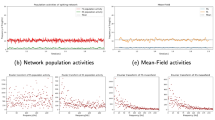Abstract
We use a mean-field macrocolumn model of the cerebral cortex to offer an interpretation of the K-complex of the electroencephalogram to complement those of more detailed neuron-by-neuron models. We interpret the K-complex as a momentary excursion of the cortex from a stable low-firing state to an unstable high-firing state, and hypothesize that the related slow oscillation can be considered as the periodic oscillation between two meta-stable solutions of the mean-field model. By incorporating a Hebbian-style learning rule that links the growth in synapse strength to fluctuations in soma potential, we demonstrate a self-organization behaviour that draws the modelled cortex close to the edge of stability of the low-firing state. Furthermore, a very slow oscillation can occur in the excitability of the cortex that has similarities with the infra-slow oscillation of sleep.
Similar content being viewed by others
References
Amzica F, Steriade M (2002) The functional significance of Kcomplexes. Sleep Med. Rev. 6: 139–149.
Bazhenov M, Timofeev I, Steriade M, Sejnowski TJ (2002) Model of thalamocortical slow-wave sleep oscillations and transitions to activated states. J. Neurosci. 22: 8691–8704.
Bienenstock E, Lehmann D (1998) Regulated criticality in the brain? Adv. Comp. Syst. 1: 361–384.
Bienenstock EL, Cooper LN, Munro PW (1982) Theory for the development of neuron selectivity: orientation specificity and binocular interation in visual cortex. J. Neurosci. 2: 32–48.
Bojak I, Liley DTJ (2005) Modelling the effects of anaesthesia on the electroencephalogram. Phys. Rev. E 71: 41902.
Colrain IM (2005) The K-complex: A 7-decade history. Sleep 28(2): 255–273.
Compte A, Sanchez-Vives MV, McCormick DA, Wang XJ (2003) Cellular and network mechanisms of slow oscillatory activity (<1 Hz) and wave propagations in a cortical network model. J. Neurophysiol. 89: 2707–2725.
Contreras D, Destexhe A, Sejnowski TJ, Steriade M (1997) Spatiotemporal patterns of spindle oscillations in cortex and thalamus. J. Neurosci. 17: 1179–1196.
Destexhe A, Contreras D, Steriade M (1999) Spatiotemporal analysis of local field potentials and unit discharges in cat cerebral cortex during natural wake and sleep states. J. Neurosci. 19(11): 4595–4608
Freeman WJ (1992) Predictions on neocortical dynamics derived from studies in paleocortex. In: E Basar, TH Bullock, eds., Induced Rhythms of the Brain, Birkhaeuser, Boston, pp. 183–199.
Gardiner CW (2003) Handbook of Sochastic Methods for Physics, Chemistry and the Natural Sciences, Springer series in synergetics, Springer-Verlag, Berlin, Heidelberg, New York.
Golomb D, Amitai Y (1997) Propagating neuronal discharges in neocortical slices: Computational and experimental study. J. Neurophysiol. 78(3): 1199–1211.
Hebb DO (1949) The Organization of Behaviour, Wiley, New York.
Hill S, Tononi G (2005) Modeling sleep and wakefulness in the thalamocortical system. J. Neurophysiol. 93: 1671–1698.
Kramer MA, Kirsch HE, Szeri AJ (2005) Pathalogical pattern formation and epileptic seizures. J. Royal Soc. Interface 2: 113–127.
Liley DTJ, Cadusch PJ, Wright JJ (1999) A continuum theory of electro-cortical activity. Neurocomputing 26–27: 795–800.
Marshall L, Mölle M, Born J (2003) Spindle and slow wave rhythms at slow wave sleep transitions are linked to strong shifts in the cortical direct current potential. Neuroscience 121: 1047–1053.
Massimini M, Huber R, Ferrarelli F, Hill S, Tononi G (2004) The sleep slow oscillation as a traveling wave. J. Neurosci. 24: 6862–6870.
Numminen J, Makela JP, Hari R (1996) Distributions and sources of magnetoencephalographic K-complexes. Electroencephalograpr. Clin. Neurophysil. 99: 544–555.
Nunez PL (1974) The brain wave function: A model for the EEG. Math. Biosci. 21: 279–297.
Pace-Schott EF, Hobson JA (2002) The neurobiology of sleep: genetics, cellular physiology and subcortical networks. Nature Rev.: Neurosci. 3: 591–605.
Patenaude C, Massicotte G, Lacaille J-C (2005) Cell-type specific GABA synaptic transmission and activity-dependent plasticity in rat hippocampal stratum radiatum interneurons. Eur. J. Neurosci. 22: 179–188.
Rennie CJ, Wright JJ, Robinson PA (2000) Mechanisms for cortical electrical activity and emergence of gamma rhythm. J. Theor. Biol. 205: 17–35.
Robinson PA, Rennie CJ, Wright JJ (1997) Propagation and stability of waves of electrical activity in the cerebral cortex. Phys. Rev. E 56: 826–840.
Robinson PA, Wright JJ, Rennie CJ (1998) Synchronous oscillations in the cerebral cortex. Phys. Rev. E 57: 4578–4588.
Sanchez-Vives MV, McCormick DA (2000) Cellular and network mechanisms of rhythmic recurrent activity in neocortex. Nat. Neurosci. 3: 1027–1034.
Steriade M, Núnez A, Amzica F (1993) A novel slow (<1 Hz) oscillation of neocortical neurons in vivo: Depolarizing and hyperpolarizing components. J. Neurosci. 13: 3252–3265.
Steriade M, Timofeev I, Grenier F (2001) Natural waking and sleep states: A view from inside neocortical neurons. J. Neurophysiol. 85: 1969–1985.
Steyn-Ross DA, Steyn-Ross ML, Sleigh JW, Wilson MT, Gillies IP, Wright JJ (2005) The sleep cycle modelled as a cortical phase transition. J. Biophys. 31: 543–565.
Steyn-Ross ML, Steyn-Ross DA, Sleigh JW (2004) Modelling general anaesthesia as a first-order phase transition in the cortex. Prog. Biophys. Mol. Biol. 85: 369–385.
Steyn-Ross ML, Steyn-Ross DA, Sleigh JW, Wilson MT, Wilcocks LC (2005) A mechanism for learning and memory erasure in a white-noisedriven sleeping cortex. Phys. Rev. E 72: 061910
Vanhatalo S, Palva JM, Holmes MD, Miller JW, Voipio J, Kaila K (2003) Infraslow oscillations modulate excitability and interictal epileptic activity in the human cortex during sleep. Proc. Natl. Acad. Sci. 101: 5053–5057.
Wilson MT, Steyn-Ross ML, Steyn-Ross DA, Sleigh JW (2005) Predictions and simulations of cortical dynamics during natural sleep using a continuum approach. Phys. Rev. E 72: 051910
Wright JJ, Liley DTJ (1996) Dynamics of the brain at global and microscopic scales: Neural networks and the EEG. Behav. Brain Sci. 19: 285–316.
Author information
Authors and Affiliations
Corresponding author
Additional information
Action Editor: Nicolas Brunel
Rights and permissions
About this article
Cite this article
Wilson, M.T., Steyn-Ross, D.A., Sleigh, J.W. et al. The K-complex and slow oscillation in terms of a mean-field cortical model. J Comput Neurosci 21, 243–257 (2006). https://doi.org/10.1007/s10827-006-7948-6
Received:
Revised:
Accepted:
Published:
Issue Date:
DOI: https://doi.org/10.1007/s10827-006-7948-6




